vatican
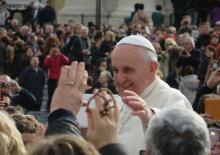
Pope Francis likes to say that he prefers to raise questions rather than issue edicts or change doctrine, and he has certainly generated plenty of debate with his off-the-cuff remarks about gays and his cold-call chats on topics like divorce and Communion, as happened recently with a woman in Argentina.
Now a recent conversation between the pope and a bishop from Brazil about the priest shortage may be moving the issue of married clergy onto the pontiff’s agenda.
During the meeting, Krautler and Francis compared notes on how much the priest shortage affects the church, especially in the Southern Hemisphere. Krautler’s diocese, geographically the largest in Brazil, has just 27 priests for 700,000 Catholics, most of whom might attend Mass a couple of times a year.
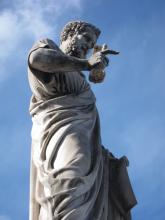
When Pope Francis canonizes Popes John XXIII and John Paul II on Sunday, Catholics across the spectrum will have reason to cheer: Liberals credit John with opening the church to the modern world in the 1960s, and conservatives hail John Paul as reasserting orthodoxy after too many innovations.
But the unprecedented double-barreled canonization also raises a question that might give both sides pause: Why is Rome making saints of almost every modern pontiff after nearly a millennium when almost no popes were canonized?
In the first 500 years of Christianity, the Apostle Peter (considered the first pope by tradition) and 47 of his 48 papal successors were viewed as saints, mainly because so many of them were martyred, which is the simplest route to canonization. Another 30 popes were named saints in the next 500 years, largely based on their reputation for sanctity.
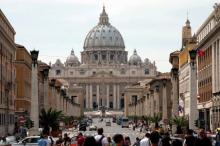
Hundreds of pilgrims wind their way around St. Peter’s Square as tour guides shout in multiple languages. Beggars have their hands outstretched amid warnings of an invasion of pickpockets from abroad.
Italian authorities are expecting at least a million pilgrims, including heads of state, prime ministers, and diplomats from 54 countries. One group of Polish pilgrims is making the 2,000-mile trek on horseback, dressed in medieval costumes, to celebrate Poland’s most famous native son.
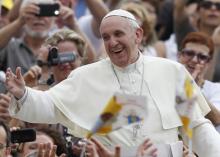
On Thursday evening, in a familiar reprise of an ancient rite, Bishop Robert Morlino of Madison, Wis., will wash the feet of 12 men, all seminarians — a re-creation of Jesus’ action at the Last Supper when he washed the feet of his disciples and, according to Catholic doctrine, formally instituted the priesthood.
That same evening, thousands of miles away, Pope Francis will also observe the Holy Thursday rite, though not in a cathedral like Morlino but at a center for people with disabilities. There he will wash the feet of a number of residents, all lay people and perhaps some of them women and even non-Christians or nonbelievers.
Francis did something similar last year, shortly after his election, when he stunned church observers by traveling to a juvenile detention center outside Rome and washing the feet of 12 young people, two of them women and two of them Muslims.
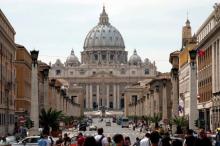
VATICAN CITY — While millions of pilgrims are expected to attend the Catholic Church’s first-ever double canonization at the end of April, the Vatican is preparing its most ambitious TV and social media campaign for the millions who don’t make it to Rome.
For the first time viewers will be able to watch the historic event live in 3-D movie theaters in 20 countries across North and South America and Europe through a deal between Vatican TV and Rupert Murdoch’s Sky TV network, Sony, and other partners. City officials are expecting more than 5 million people to attend the ceremony when Pope Francis declares his predecessors Pope John Paul II and Pope John XXIII saints in St Peter’s Square on April 27.

The news that Pope Francis fired — or “accepted the resignation of” — the German churchman known as “Bishop Bling” because of his big-spending ways has touched off speculation among Catholics that other dismissals could be in the offing.
Here’s the answer in four words: Perhaps, but probably not.
Recent history shows why: Bishop Robert Finn of Kansas City, Mo., remains in office 18 months after his conviction – and $1.4 million spent on his defense — for failing to report a priest suspected of abuse. Los Angeles Cardinal Roger Mahony enjoys a high-profile retirement in spite of the disapproval of his own successor over Mahony’s abuse record. Similarly, Cardinal Bernard Law, formerly of Boston, is still living a gilded existence in Rome years after he was plucked from the U.S. amid the clergy abuse scandal.

Thirty years ago, when the United States established full diplomatic relations with the Holy See, critics of the move fell into two camps.
One group worried that the Vatican would try to unduly influence the U.S., where anti-Catholicism lies barely beneath the skin. Indeed, Harvard historian Arthur Schlesinger Sr. once called anti-Catholicism “the deepest bias of the American people.” Poet Peter Viereck of Mount Holyoke College called anti-Catholicism “the anti-Semitism of the intellectuals.”
Those in the other camp worried that the U.S. would try to unduly influence the Vatican. They complained, for example, that the U.S. would lobby the Vatican’s Pontifical Academy of Sciences to make it refrain from criticizing the now barely remembered Star Wars program, which the U.S. was promoting in the 1980s as part of our national defense system.

When President Obama and Pope Francis sit down at the Vatican on Thursday, the meeting may well offer a vision of what could have been for Democrats and the Catholic Church over the last six years: a leader of the state and a leader of the church working on the many issues where they agree while working through the issues where they don’t.
Of course, that’s not exactly how it’s gone for Obama and the U.S. hierarchy, even though Obama and the church both stress economic justice and the priority of the common good, universal health care, robust government support for the needy and comprehensive immigration reform.
The potential for a robust alliance fizzled almost from the start of Obama’s candidacy in 2007, and a relationship that began badly went downhill when he was elected.

President Obama is to meet Pope Francis for the first time next week as Obama wraps up a European tour, a high-profile encounter between two major world leaders that appears to carry especially high stakes from the U.S. perspective.
The White House and the American bishops have been at loggerheads for years on a range of culture war issues, and on Tuesday, just two days before the Vatican meeting, the U.S. Supreme Court will hear oral arguments on the contraception mandate that has sparked fierce opposition from the U.S. hierarchy.
But American and Vatican officials say the talks may disappoint those hoping for fireworks, and that the summit is going to focus on collaboration much more than conflict.

The Vatican said Monday that Pope Francis will preside over a prayer vigil dedicated to victims of mob violence in Italy and their families.
The special service, to be held Friday, is expected to include at least 700 Italians who lost a family member to violence connected to Italy’s various organized crime organizations.
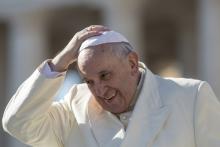
Today the world celebrates Pope Francis’ first year. Notice I didn’t say the church is celebrating, but the world. The pope has graced the covers of every magazine from TIME to Rolling Stone over the past year. People all over the world are delighted by the breath of fresh air he has brought. His popularity has moved beyond Catholics to Christians of all kinds, believers from other faith traditions, agnostics, and the “nones,” who are very drawn to this pope who emphasizes love and simple living.
But the pope said last week that he is not a “ superman” and does not want to be a celebrity. He is just trying to talk and live like Jesus, a point he makes repeatedly to shrug off his media darling standing. From the moment he took the name Francis, he made clear his, and thus the church’s priorities: the poor, peace, and the creation. Francis is now challenging the most powerful people and places in the world, as well as a popular culture that mostly asks how we can serve ourselves.
Pope Francis is right: it is not about him; it’s about the Christ he follows. Everything Francis is saying and doing is aimed at pressing this question: Are Christians going to follow Jesus or not? That should be the question on the first anniversary of this new pope. Are we Christians ready and willing to follow Jesus? How can we then serve the world?

So what’s it like to come to work every day when your boss is the pope?
Much also depends on whether you are one of the approximately 3,500 (mostly Italian) lay people in the Vatican’s workforce or one of the 1,100 or so cardinals, bishops, priests, or religious brothers and sisters who tend to occupy decision-making positions and are deeply invested in the policies that Francis adopts.
That second group, often defined by their ideologies and rivalries, tends to draw the most attention, given the high stakes and fierce passions involved.

Figuring out why Pope Francis has upended so many expectations, how exactly he’s changed the Catholic Church in his first year and what he might be contemplating for the future has become a Catholic parlor game that is almost as popular as the pontiff himself.
A single key can best answer all of these questions: Francis’ longstanding identity as a Jesuit priest.
It’s an all-encompassing personal and professional definition that the former Cardinal Jorge Bergoglio brought with him from Buenos Aires, and one that continues to shape almost everything he does as Pope Francis.
“He may act like a Franciscan but he thinks like a Jesuit,” quipped the Rev. Thomas Reese, a fellow Jesuit who is a columnist for National Catholic Reporter.

Cardinal Timothy Dolan said Sunday that Pope Francis is asking the Catholic Church to look at the possibility of recognizing civil unions for gay couples, although the archbishop of New York said that he would be “uncomfortable” if the church embraced that position.
Francis said the churches in various countries must account for those reasons when formulating public policy positions. “We must consider different cases and evaluate each particular case,” he said.
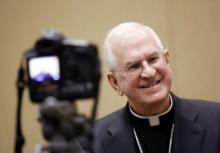
After I met Pope Francis during a visit to the Holy See in October, I remarked that if I were choosing a parish based upon the pastor, he would be my pastor. Now, he is the world’s pastor.
Since his election a year ago on March 13, Pope Francis has provided inspiration in many ways:
As a communicator, he speaks in a fresh and creative yet very simple style. And like Jesus, he uses images that people understand while communicating profound theological truth. Forthright, authentic, and courageous in his communication, Pope Francis also humorously challenges us, as he calls us not to be “sourpusses,” “whiners,” or “princes.”

Pope John Paul II won’t officially become a saint until a special high-profile ceremony next month at the Vatican. But the man who succeeded him says he has seen him in that light for years.
The Polish pontiff “did not ask for applause and never looked troubled when he was making difficult decisions,” Benedict said. “He acted in accord with his faith and beliefs, and he was willing to endure blows against him. I could and should not imitate him, but I did try to continue his legacy and his mission the best way I could.”
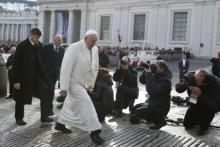
When cardinals gathered in the Sistine Chapel a year ago to choose a successor to Pope Benedict XVI, a frail 85-year-old who had become the first pope in six centuries to resign, many of them had one non-negotiable for the next pontiff: that he not be over 70 years old.
So what did the cardinals do? They elected 76-year-old Cardinal Jorge Bergoglio of Argentina — a man who had part of a lung removed in his 20s and who today “walks kind of crookedly,” as a former aide once put it, because he wears orthopedic shoes to help alleviate chronic lower back pain.
All in all, though, Pope Francis, now 77, seems to be doing quite well at the one-year mark of his papacy, despite maintaining a nonstop pace of liturgies, meetings, public appearances, and hours of prayer throughout a day that starts before 5 a.m.
“He eats works, it’s true,” said the Rev. Antonio Spadaro, a Jesuit priest — like Francis — who conducted a book-length interview with the pope last year and knows him well.

As Pope Francis approaches the one-year mark of his papacy, his global flock and a fascinated public are starting to measure the changes he is making against the sky-high hopes for transforming an institution many thought impervious to change.
Every personnel move and every new proposal is being scrutinized for what it might indicate about the direction of the church, what it might augur about possible adjustments to church teaching and whether the aspirations of so many will be fulfilled — or frustrated.
But as important as such structural and policy moves can be, church leaders and Vatican insiders say the 77-year-old Francis is really focused on a more ambitious (and perhaps more difficult) goal: overhauling and upending the institutional culture of Catholicism.
Francis, they say, is bent on converting the church, as it were, so that the faith is positioned to flourish in the future no matter who follows him to the throne of St. Peter.

In another strongly worded message to the Catholic hierarchy, Pope Francis on Thursday told the Vatican body that vets nominees for bishops that they need to find him better candidates to send to dioceses around the world.
“To choose such ministers we all need to raise our sights, to move to a higher level,” Francis told the Congregation for Bishops, the critical department of the Roman Curia that acts as a clearinghouse for bishop nominees. “We can’t do anything less, and we can’t be content with the bare minimum.”
On consecutive days last weekend, Francis delivered stern warnings to 19 new cardinals he appointed to join about 150 others in the College of Cardinals: On Saturday, he told them to avoid “rivalry, jealousy, factions,” and at a Mass in the Vatican on Sunday, he said they must reject “habits and ways of acting typical of a court: intrigue, gossip, cliques, favoritism, and preferences.”
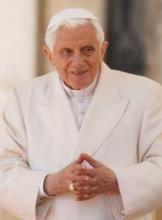
As the anniversary of his surprising resignation approaches, Pope Benedict XVI has rejected as “simply absurd” the speculation that he was forced to step down, and he said he still wears the distinctive white papal cassock for “purely practical reasons.”
“At the moment of my resignation there were no other clothes available,” Benedict wrote in a brief letter to an Italian journalist that was published on Wednesday.
The emeritus pope also said that he kept the name Benedict, rather than reverting to his birth name of Joseph Ratzinger, because it was a simple solution.